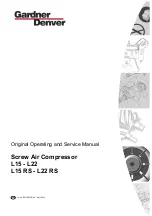
Installation and service
Maximum compressor test pressure at low pressure side
(suction side)
25 bar (g)
Maximum compressor test pressure at high pressure side
(discharge side)
30 bar (g)
Maximum test pressure difference between high and low pressure side (to avoid
that the internal compressor relief valve will open)
30 bar
System pressure test
Compressor connection
to the system
Always use an inert gas such as nitrogen for
the pressure test. Never use other gasses such
as oxygen, dry air or acetylene. These gasses
may form an inflammable mixture with the
compressor oil. Always use the appropriate
pressure regulator with gas cylinders. Any
attempt to use a high pressure gas supply
without a suitable pressure regulator can lead
to personal injury or death as well as system
damage.
The maximum allowed test pressures for NTZ
compressors are:
New compressors have a protective nitrogen
holding charge.
R
Only remove the suction and discharge
plugs just before connecting the compressor to
the installation, so as to prevent air and moisture
from entering the compressor. Remove the
discharge plug first and the suction plug next; by
proceeding as such, the nitrogen holding charge
can escape via the discharge connection and
the risk of an oil mist blow-out via the suction
connection will be minimal.
Whenever possible the compressor must be the
last component to be integrated in the system. It
is advisable to braze the solder sleeves or service
valves to the pipework before the compressor
is mounted. when all brazing is finished and
when the total system is ready, the compressor
plugs can be removed and the compressor can
be mounted to the system with a minimum
exposure to ambient air. If this procedure is not
possible, the sleeves or valves may be brazed to
the pipes when mounted on the compressor. In
this situation nitrogen or CO
2
must be purged
through the compressor via the schrader valve
to prevent air and moisture ingress. Purging
must start when the plugs are removed and
maintained during the brazing process.
When rotolock valves are used on the
compressor, they shall be closed immediately
after mounting, thus keeping the compressor
isolated from atmosphere or from a not yet
dehydrated system.
Note:
when the compressor is built into a "pack"
or "rack" configuration which is not installed
immediately on its final location, a vacuum pull-
down and moisture removal must be performed
to the "pack" or "rack" as if it were a complete
system (see below). the pack must be charged
with nitrogen or CO
2
and open tubes must be
blocked with caps or plugs.
27
AB245486497018en-000601
Application Guidelines










































